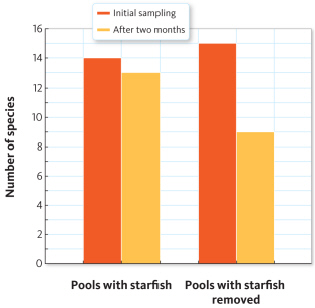Robert Paine was the first biologist to use the term keystone species in the 1960s. He was studying food webs in the rocky, intertidal pools in the Pacific Northwest. At one of his study sites, the dominant organisms in the tidal pools were mussels, barnacles, whelks, and a species of starfish known as Pisaster ochraceus . To examine the relationship between these species, Paine set up an experiment. In one area, he removed all the starfish from the tidal pools, and in an adjacent area, he left the tidal pools as he found them. Prior to removing the starfish, he sampled all the organisms in each pool. After two months, he repeated this sampling. A summary of his results is illustrated in the graph below.
As mussels and barnacles feed, how much of the energy that they take in from food is available to the whelks that eat them?
Definitions:
Astrocytes
A type of glial cell in the brain and spinal cord involved in physical and nutritional support for neurons, as well as neurotransmitter regulation.
Brain Tumor
An abnormal and often uncontrolled growth of cells in the brain, which can be malignant (cancerous) or benign (non-cancerous).
Seizure
A sudden, uncontrolled electrical disturbance in the brain, capable of causing changes in behavior, movements, feelings, and levels of consciousness.
Vision Loss
The partial or complete loss of sight, which can result from various conditions, injuries, or diseases affecting the eyes or brain.
Q2: Which of the following is incorrectly paired?<br>A)
Q11: During which stage do sister chromatids separate?<br>A)
Q21: Photosynthesis occurs in<br>A) leaves.<br>B) roots.<br>C) stems.<br>D) More
Q27: Which of the following are used to
Q28: An expensive software designed for professional film
Q30: Computers use special computer codes that are
Q32: Alcoholic fermentation requires _ and is an
Q40: Minerals differ from nutrients because minerals _.<br>A)
Q47: A(n) _, or command, is a word
Q50: Water moves upward in a tree due